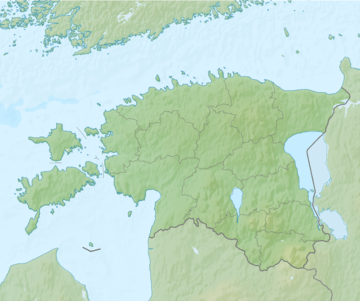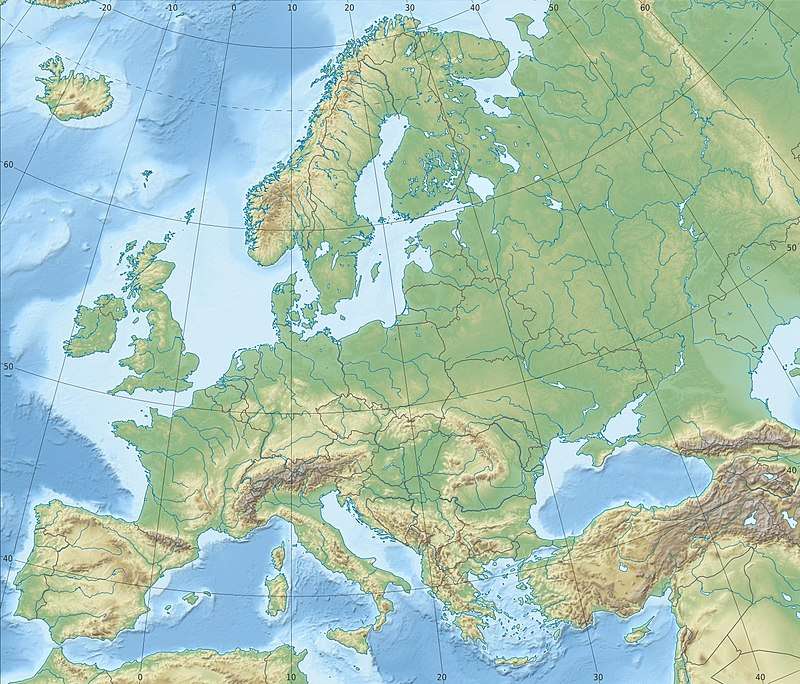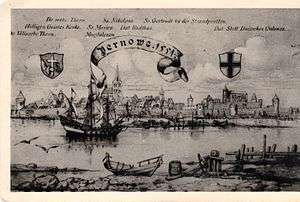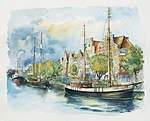Pärnu
| Pärnu Pärnu linn City of Pärnu | |||
|---|---|---|---|
| City | |||
.jpg) Pärnu beach | |||
| |||
 Pärnu Location of Pärnu in Estonia  Pärnu Pärnu (Europe) | |||
| Coordinates: 58°23′N 24°30′E / 58.383°N 24.500°ECoordinates: 58°23′N 24°30′E / 58.383°N 24.500°E | |||
| Country | Estonia | ||
| County | Pärnu County | ||
| Founded | 1251 | ||
| Government | |||
| Area | |||
| • Total | 859 km2 (332 sq mi) | ||
| Elevation | 10 m (30 ft) | ||
| Population (2017) | |||
| • Total | 51,739 | ||
| • Rank | 4th | ||
| • Density | 60/km2 (160/sq mi) | ||
| Ethnicity | |||
| • Estonians | 83% | ||
| • Russians | 12% | ||
| • other | 5% | ||
| Time zone | UTC+2 (EET) | ||
| • Summer (DST) | UTC+3 (EEST) | ||
| Area code(s) | (+372) 44 | ||
| Vehicle registration | F | ||
| Website | www.parnu.ee | ||
Pärnu (Estonian pronunciation: [ˈpærˑnu]; German: Pernau) is the fourth-largest city in Estonia. Located in southwestern Estonia on the coast of Pärnu Bay, an inlet of the Gulf of Livonia in the Baltic Sea. It is a popular summer holiday resort with many hotels, restaurants, and large beaches. The Pärnu River flows through the city and drains into the Gulf of Riga. The city is served by Pärnu Airport.
History

Perona (German: Alt-Pernau, Estonian: Vana-Pärnu) was founded by the bishop of Ösel–Wiek ca. 1251, suffered heavily under pressure of the concurrent town, and was finally destroyed ca. 1600. Another town, Embeke (later German: Neu-Pernau, Estonian: Uus-Pärnu) was founded by the Livonian Order, who began building an Ordensburg nearby in 1265. The latter town, then known by the German name of Pernau, was a member of the Hanseatic League and an important ice-free harbor for Livonia. The Polish–Lithuanian Commonwealth took control of town between 1560–1617; the Poles and Lithuanians fought the Swedes nearby in 1609. Sweden took control of the town during the 16th-century Livonian War, but it was subsequently taken by the Russian Empire in the 1710 Capitulation of Estonia and Livonia and the 1721 Treaty of Nystad, following the Great Northern War. It belonged to Imperial Russian Governorate of Livonia then. The city is occasionally referred to as Pyarnu, an incorrect reverse-transliteration from Russian Пярну.
The town became part of independent Estonia in 1918 following World War I.
The city was occupied by the Soviet Red Army along with the rest of Estonia in 1940 during World War II, and its German population left the town. It was then occupied by Germany from 1941 until 1944 before it was reoccupied by the Soviet Union as part of the Estonian Soviet Socialist Republic from 1944-1991.
During the Great Northern War, the University of Dorpat (Tartu) was relocated to Pernau from 1699–1710. The university has a branch campus in Pärnu today (1,000 students in the 2004/2005 school year).[1]
Geography
Climate
Pärnu lies within the temperate humid continental climate zone.
| Climate data for Pärnu (1981–2010) | |||||||||||||
|---|---|---|---|---|---|---|---|---|---|---|---|---|---|
| Month | Jan | Feb | Mar | Apr | May | Jun | Jul | Aug | Sep | Oct | Nov | Dec | Year |
| Record high °C (°F) | 9.0 (48.2) |
8.3 (46.9) |
18.1 (64.6) |
26.2 (79.2) |
31.2 (88.2) |
32.6 (90.7) |
33.2 (91.8) |
31.8 (89.2) |
28.0 (82.4) |
22.4 (72.3) |
12.0 (53.6) |
10.3 (50.5) |
33.2 (91.8) |
| Average high °C (°F) | −1.1 (30) |
−1.6 (29.1) |
2.4 (36.3) |
9.6 (49.3) |
16.4 (61.5) |
19.9 (67.8) |
22.5 (72.5) |
21.2 (70.2) |
15.8 (60.4) |
9.8 (49.6) |
3.6 (38.5) |
0.2 (32.4) |
9.9 (49.8) |
| Daily mean °C (°F) | −3.5 (25.7) |
−4.5 (23.9) |
−1.0 (30.2) |
4.8 (40.6) |
11.4 (52.5) |
15.2 (59.4) |
18.0 (64.4) |
16.9 (62.4) |
11.9 (53.4) |
6.9 (44.4) |
1.6 (34.9) |
−1.9 (28.6) |
6.3 (43.3) |
| Average low °C (°F) | −5.9 (21.4) |
−7.2 (19) |
−4 (25) |
1.1 (34) |
6.6 (43.9) |
10.8 (51.4) |
13.7 (56.7) |
13.0 (55.4) |
8.5 (47.3) |
4.2 (39.6) |
−0.5 (31.1) |
−4.4 (24.1) |
3.0 (37.4) |
| Record low °C (°F) | −32.7 (−26.9) |
−28.5 (−19.3) |
−22.7 (−8.9) |
−10.7 (12.7) |
−3.6 (25.5) |
1.6 (34.9) |
4.0 (39.2) |
3.7 (38.7) |
−3.1 (26.4) |
−10.3 (13.5) |
−22.2 (−8) |
−24.2 (−11.6) |
−32.7 (−26.9) |
| Average precipitation mm (inches) | 60 (2.36) |
44 (1.73) |
44 (1.73) |
37 (1.46) |
37 (1.46) |
73 (2.87) |
79 (3.11) |
79 (3.11) |
67 (2.64) |
83 (3.27) |
75 (2.95) |
67 (2.64) |
746 (29.37) |
| Average relative humidity (%) | 88 | 86 | 82 | 75 | 70 | 74 | 76 | 79 | 83 | 86 | 89 | 89 | 81 |
| Mean monthly sunshine hours | 35.9 | 67.9 | 130.7 | 198.7 | 288.9 | 281.3 | 297.4 | 246.9 | 159.7 | 95.5 | 39 | 26.1 | 1,863.6 |
| Source: Estonian Weather Service[2][3][4][5] | |||||||||||||
Waterbodies
Pärnu jõgi, Sauga jõgi, Reiu jõgi, Pärnu moat, Pärnu bay.
Demography
Population change
| Year | 1881 | 1897 | 1922 | 1934 | 1959 | 1970 | 1979 | 1989 | 2000 | 2011 | 2012 | 2017 |
|---|---|---|---|---|---|---|---|---|---|---|---|---|
| Population | 12,966 | 12,898 | 18,499 | 20,334 | 22,367 | 50,224 | 54,051 | 53,885 | 45,500 | 39,728 | 40,401 | 40700 |
Ethnic groups
| Nationality | 2000 census | 2011 census[6] | ||
|---|---|---|---|---|
| Number | % | Number | % | |
| Estonians | 36,112 | 79.37 | 33,000 | 83.07 |
| Russians | 6,951 | 15.28 | 5,076 | 12.78 |
| Ukrainians | 966 | 2.12 | 671 | 1.69 |
| Finns | 331 | 0.73 | 254 | 0.64 |
| Belarusians | 297 | 0.65 | 179 | 0.45 |
| Total | 45,500 | 39,728 | ||
| Language | 2000 census[7] | 2011 census[6] | ||
|---|---|---|---|---|
| Number | % | Number | % | |
| Estonian | 35,928 | 78.96 | 32,762 | 82.47 |
| Russian | 8,360 | 18.37 | 6,263 | 15.77 |
| Ukrainian | 426 | 0.94 | 245 | 0.62 |
| Finnish | 163 | 0.36 | 129 | 0.33 |
| Belarusian | 100 | 0.22 | 32 | 0.08 |
| Total | 45,500 | 39,728 | ||
Administration
Local administration consists of the town council and the town government. Town council elections take place every four years. The number of councillors depends on the population. The current number of councillors is 33.
Economy
Today Pärnu is an economically balanced region with a comprehensive range of industries. Foreign investments and new businesses with up-to-date technologies have enhanced job creation and higher competitiveness of the businesses in the world markets. Several enterprises of Pärnu region stand out as the best in Estonia.
Significant flows of exports from Pärnu region and South-Estonia pass through the Port of Pärnu which lies at the mouth of the Pärnu River. In recent years, the port has developed into an important regional harbour for south-western and southern Estonia.
Pärnu’s fame as a rehabilitation and holiday resort dates back to the middle of the 19th century. The foundation of the first bathing facility in 1838 is considered the birth date of Pärnu resort. Today Pärnu has all desirable qualities of a modern holiday resort – it has spas and rehabilitation centres, hotels, conference and concert venues, golf courses and tennis courts, restaurants and pubs. Long tradition of as a resort has made Pärnu well known in Finland and other Scandinavian countries.
Tourism
Majority of the tourists in Pärnu are Finns, Swedes and Russians.
In 1837, a tavern near the beach was made into a bathing establishment. The establishment accommodated 5–6 bathrooms that provided hot seawater baths in summer and operated as a sauna in winter. The wooden building was burnt down in the course of World War I. In 1927, the present stone building of Pärnu Mud Baths was erected at the same site.
Since 1996 Pärnu has been known as Estonia's Summer Capital.[8][9]
Starting from 2015 the city of Pärnu hosts the annual Weekend Festival, the largest dance music festival in the Nordic and Baltic region. Stages are headlined by DJs from across the electronic dance music spectrum, with audiovisual support. Some of the past and upcoming artists to perform include Martin Garrix, David Guetta, Avicii, Steve Aoki, The Chainsmokers, Tiësto, Armin van Buuren, Hardwell, Robin Schulz, Afrojack, deadmau5, Knife Party and many more.
Twin towns and sister cities
|
|
|
Citizens of honour
- 1886 Konstantin Possiet
- 1901 Friedrich Fromhold Martens
- 1934 Konstantin Päts
- 2007 Neeme Järvi
- 2008 Valter Ojakäär
- 2009 Jüri Jaanson[12]
Notable residents
- Gustav Fabergé, jeweller
- Johann Voldemar Jannsen, Estonian journalist and poet
- Tõnis Kasemets, race-car driver who has competed in ChampCar and IMSA
- Paul Keres, chess grandmaster
- Lydia Koidula, poet
- Friedrich Martens, lawyer
- David Oistrakh, violinist
- Rasmus Rändvee, singer
- Salme Reek, actress
- Georg Wilhelm Richmann, German physicist
- David Samoylov, poet
- August Sang, poet
- Olev Siinmaa, architect
- David Shrayer-Petrov, poet, fiction writer, translator, medical scientist
- Maxim D. Shrayer, author and literary scholar
- Avo Sõmer, musicologist, music theorist, composer
References
- ↑ University of Tartu Pärnu College
- ↑ "Climate normals-Temperature". Estonian Weather Service. Retrieved 27 September 2016.
- ↑ "Climate normals-Precipitation". Estonian Weather Service. Retrieved 27 September 2016.
- ↑ "Climate normals-Humidity". Estonian Weather Service. Retrieved 27 September 2016.
- ↑ "Climate normals-Sunshine". Estonian Weather Service. Retrieved 27 September 2016.
- 1 2 http://pub.stat.ee/px-web.2001/I_Databas/Population_census/PHC2011/01Demographic_and_ethno_cultural_characteristics/04Ethnic_nationality_Languages_Dialects/04Ethnic_nationality_Languages_Dialects.asp
- ↑ http://pub.stat.ee/px-web.2001/I_Databas/Population_census/PHC2000/08Ethnic_nationality._Mother_tongue._Command_of_foreign_languages/08Ethnic_nationality._Mother_tongue._Command_of_foreign_languages.asp
- ↑ suvepealinn
- ↑ Short history – VisitPärnu.com
- ↑ "Sõpruslinnad". Pärnu linn (in Estonian). Retrieved 14 February 2017.
- ↑ Lindquist, Ted. "Internationella frågor och vänorter". Oskarshamn Municipality (in Swedish). Archived from the original on 2013-08-12. Retrieved 2013-07-25.
- ↑ Pärnu linn: Pärnu aukodanik Archived 2013-11-09 at the Wayback Machine.
Maxim D. Shrayer. Dunes of Happiness: Fifteen Summers in Estonia. Baltic Worlds (September 2013).
External links
| Wikimedia Commons has media related to Pärnu. |
| Wikivoyage has a travel guide for Pärnu. |


.jpg)


